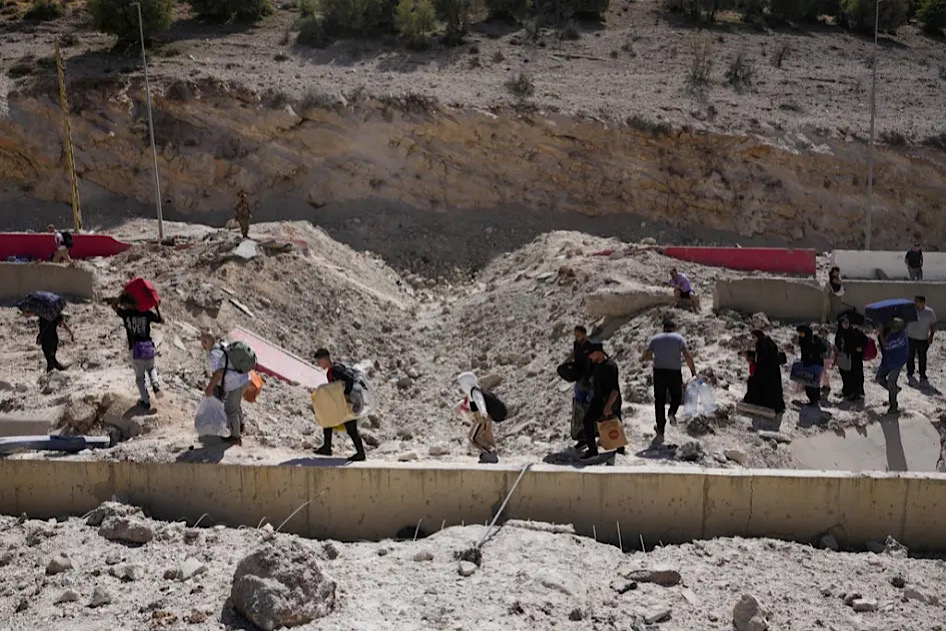Israel hits border crossings between Lebanon and Syria, blocking refugee escape routes
Israel accuses Hezbollah of using the crossings to move weapons and military equipment between the two countries. Up to half a million people have crossed the border into Syria since the opening of Israel’s "northern front". Airstrikes also affect civilians and block business activities and trade. The IDF issued an evacuation order for Tyre.
Beirut (AsiaNews) – A large number of Syrian refugees fleeing Lebanon to escape Israeli airstrikes against Hezbollah targets, which end up hitting civilians, walked home yesterday, crossing a makeshift bridge in the Qusai area, Homs province.
Despite the risks, this became necessary after the official border crossing between Lebanon and Syria was hit and made unusable by Israeli warplanes three days ago.
Only three border crossings between the two countries were open, along the 375-kilometre border.
In late September, an Israeli airstrike hit the Matraba border crossing in northeastern Lebanon, forcing it to close. A few weeks later, warplanes hit the Masnaa crossing, which is still the main crossing between the two countries, putting it out of service. Last week, it was the turn of the Jousieh crossing.
The escalation is exacerbating the humanitarian crisis. Israel has justified its actions saying that Hezbollah is using the crossings to move weapons and military equipment from Syria to Lebanon on Israel’s northern front, while the war against Hamas continues in Gaza.
However, for humanitarian groups and international organisations, the closure of crossing points has made an already serious humanitarian crisis much worse, effectively blocking the main routes for supplies into the country and people fleeing for safety.
Many of those escaping are Syrians who a decade ago fled their own country after it was plunged into a civil war pitting the regime of President Bahsar al-Assad against rebel and jihadi groups, which eventually turned into a regional proxy war.
Ghossoun Mubarak, who fled the city of Baalbek in eastern Lebanon with her three children, called the airstrikes a “tragedy.” All four walked across the makeshift bridge yesterday, not without risks, but the structure represents, at least for now, the only way to safety.
According to the UN Refugee Agency (UNHCR), at least 430,000 people have crossed from Lebanon into Syria since Israel started an airstrike and ground invasion of Lebanon a month ago. In Beirut government officials put the number at more than half a million people.
UNHCR's Rula Amin is worried about the damage to crossings, describing them as the “main lifeline for people escaping the conflict."
“Today, it was better,” said Omar Abu Jabal, 29, who was returning to Lebanon Sunday via the Jousieh crossing after a work trip. “No issues along the way. But before, there were bombings, which stopped people from moving.”
Homs’s transportation director Nabil Aakoul confirmed reports that recent attacks destroyed a bridge over the Orontes River, disrupting travel between vital agricultural areas, isolating communities reliant on cross-river trade. He estimates that bridge repair over the Orontes River alone will cost US$ 2.5 million.
Yahya Abu Youssef, who lives near the damaged bridge, described the Israeli attack as "inhumane" because in addition to material damage it injured children and livestock.
“All that’s here is a bridge connecting villages and farms,” he said, noting that villagers now face an additional 10 kilometres of travel to reach the city of Homs.
Meanwhile, the Israeli military issued an urgent evacuation notice for residents of large areas in the city of Tyre, ahead of airstrikes against Hezbollah sites.
In a note on X, formerly Twitter, Col Avichay Adraee, head of the Arab Media Division of the Israeli Defence Force (IDF), said, “Hezbollah’s activity forces the IDF to act in the area you are in,” while publishing a map of the areas that will be targeted.
“You must immediately move away from the area marked in red and head north to the Awali River,” he added. “Anyone who is near Hezbollah personnel, facilities and weapons of Hezbollah is putting their life in danger!”







.png)










